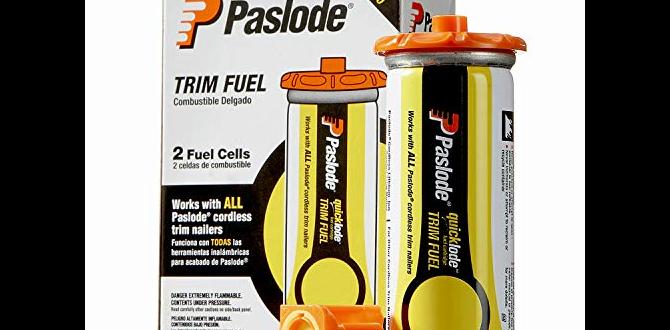Nail Gun Air Compressor Requirement: A Simplified Guide
Choosing the right air compressor for your nail gun is crucial for efficient and frustration-free DIY projects. This guide breaks down everything you need to know about CFM, PSI, tank size, and compressor types, helping you make the best choice for your woodworking and home repair needs. Get ready to power up your projects!
Hey there, fellow DIYers and woodworking enthusiasts! Jack Shaffer here from Nailerguy. Ever feel like your nail gun is letting you down, sputtering or failing to drive nails fully? More often than not, the culprit isn’t the nail gun itself, but the air compressor powering it. It’s a common hiccup that can turn a satisfying project into a real headache. But don’t worry, we’re going to clear the air and get you powered up correctly. This guide will walk you through exactly what your nail gun needs from an air compressor, making sure you get the perfect match for smooth, powerful performance on every project. Let’s dive in and make sure your tools always have the juice they need!
Table of Contents
Understanding the Heart of the Matter: Why Air Compressors Matter for Nail Guns
The Power Behind the Punch
Think of an air compressor as the powerhouse for your pneumatic nail gun. It takes in air, compresses it, and stores it under pressure. When you pull the trigger on your nail gun, this stored, pressurized air is released in a powerful burst, driving the nail into your material. Without enough air pressure or a consistent supply of air, your nail gun simply won’t perform as it should. It’s like trying to run a marathon on an empty stomach – you won’t get very far!
Common Frustrations and How to Avoid Them
We’ve all been there: your nail gun starts weak, then barely drives the nail, or worse, it jams completely. This is usually a sign of an underpowered compressor or a mismatch between the compressor and the nail gun’s needs. Sometimes, the compressor’s air tank is too small and runs out of air quickly, or the compressor itself can’t produce enough air volume (CFM) to keep up with the nail gun’s demand. The good news is, understanding a few key specifications will help you avoid these headaches and ensure your nail gun performs reliably, project after project.
Key Air Compressor Specifications for Nail Guns: The Must-Know Specs
When looking for an air compressor, you’ll see a few numbers and terms that might seem a bit daunting at first. But these are the crucial bits of information that tell you how well the compressor will work with your nail gun. Let’s break them down, nice and simple.
CFM: The Airflow Factor
CFM stands for Cubic Feet per Minute. This is arguably the MOST important spec for choosing an air compressor for nail guns. Simply put, CFM tells you how much air the compressor can deliver at a specific pressure. Your nail gun requires a certain amount of air to operate effectively. If your compressor’s CFM output is lower than what your nail gun needs, you’ll experience the frustrating issues we talked about – weak nail drives and inconsistent performance.
How to know what CFM your nail gun needs: This information is usually found in your nail gun’s manual or on the manufacturer’s website. It’s often listed as CFM @ 90 PSI. Even if it’s not explicitly stated, you can make a good estimate based on the type of nail gun. For example, framing nailers require more CFM than brad nailers.
Rule of Thumb: Always aim for a compressor that exceeds your nail gun’s CFM requirement by at least 1.5x. This buffer ensures your compressor isn’t constantly running at its absolute limit, which extends its lifespan and provides a more consistent air supply. For instance, if your nail gun needs 3.0 CFM @ 90 PSI, look for a compressor that can deliver at least 4.5 CFM @ 90 PSI.
PSI: The Pressure Is On
PSI stands for Pounds per Square Inch. This is the measure of force or pressure that the air is under. Most nail guns operate effectively within a range of 70 to 120 PSI. Your nail gun’s manual will specify the recommended operating pressure.
What to look for: The air compressor will have a regulator that allows you to set the output pressure to match your nail gun’s requirements. You want to ensure the compressor can reach and maintain the necessary PSI, even while it’s delivering air to the nail gun.
Consistency is Key: While most compressors can hit the required PSI, the real test is their ability to maintain that pressure while the nail gun is firing. This is where CFM plays a crucial role. A compressor with sufficient CFM will maintain pressure better, even under heavy use.
Tank Size: The Air Reservoir
The air compressor’s tank is its storage unit for compressed air. Tank size is measured in gallons and affects how long you can use your nail gun before the compressor has to kick on to refill the tank. It’s kind of like a rechargeable battery – a bigger battery lasts longer between charges.
Smaller Tanks (1-6 Gallons): These are typically found in portable “pancake” or “hot dog” style compressors. They are lightweight and easy to move around. They’re great for occasional use with brad nailers, finish nailers, and staplers, especially for small projects or trim work where you’re not firing nails constantly. However, for framing nailers or high-volume nailing, they might not be sufficient as the compressor will cycle on and off frequently.
Medium Tanks (10-30 Gallons): These offer a good balance between portability and air supply for many DIY projects. They can handle most finish and framing nailers for moderate use. The larger reservoir means longer run times between compressor cycles.
Large Tanks (40+ Gallons): These are less portable and often stay in garages or workshops. They are ideal for continuous use, heavy-duty applications, and running multiple nail guns or other air tools simultaneously. If you plan on doing extensive framing, siding, or deck work, a larger tank is highly recommended.
Relationship with CFM: A larger tank can sometimes compensate slightly for a compressor with a borderline CFM rating, by providing a larger buffer of air. However, it’s always best to meet or exceed the CFM requirements first and foremost.
Matching Your Nail Gun to the Right Air Compressor
The type of nail gun you have will greatly influence the air compressor you need. Let’s look at some common nail gun types and their typical air requirements.
Framing Nailers
These are the heavy-duty workhorses used for structural projects like building decks, framing walls, and fences. They drive larger nails and require a significant amount of air.
- PSI: Typically 70-120 PSI.
- CFM: Usually around 2.0 – 4.0+ CFM @ 90 PSI.
- Compressor Recommendation: You’ll want a compressor with at least 4-5 CFM @ 90 PSI and a tank size of 20 gallons or more for consistent performance. A framing nailer will drain smaller tanks very quickly.
Finish Nailers & Brad Nailers
These are used for more delicate work, like installing trim, molding, cabinets, and even furniture making. They drive smaller, thinner nails.
- PSI: Typically 70-100 PSI.
- CFM: Generally lower, around 0.5 – 2.0 CFM @ 90 PSI.
- Compressor Recommendation: Most portable pancake or hot dog compressors (around 2-3 CFM @ 90 PSI) with smaller tanks (2-6 gallons) are perfectly suited for these nailers.
Roofing Nailers
Designed for shingles, these nail guns fire quickly and repeatedly. They require a good, consistent supply of air.
- PSI: Typically 80-120 PSI.
- CFM: Usually in the range of 2.0 – 3.5 CFM @ 90 PSI.
- Compressor Recommendation: A compressor with 3-4 CFM @ 90 PSI and a tank size of at least 10-20 gallons is a good starting point to ensure uninterrupted nailing on the roof.
Staplers (Narrow Crown & Wide Crown)
Used for upholstery, sheathing, and other applications where staples are preferred. Their air requirements are similar to brad and finish nailers.
- PSI: Typically 70-100 PSI.
- CFM: Generally around 0.5 – 2.0 CFM @ 90 PSI.
- Compressor Recommendation: Similar to brad and finish nailers, a smaller, portable compressor with a 2-6 gallon tank and 2-3 CFM @ 90 PSI is usually sufficient.
Types of Air Compressors: What’s Best for Your Setup?
When you go shopping, you’ll see a few different styles of air compressors. Each has its pros and cons, especially when it comes to powering nail guns.
Portable Compressors (Pancake & Hot Dog Styles)
These are the fan favorites for DIYers and mobile professionals. They are small, lightweight, and easy to carry around the job site or workshop.
- Pros: Highly portable, relatively quiet (compared to larger units), good for small to medium nailers and intermittent use.
- Cons: Smaller tanks mean more frequent cycling of the motor, can struggle with high-CFM tools or continuous heavy use.
- Best For: Brad nailers, finish nailers, staplers, small upholstery projects.
Wheelbarrow/Twin-Stack Compressors
These offer more power and a larger air supply than typical portable units, often with two smaller tanks stacked or side-by-side. They usually have wheels for easier transport.
- Pros: Higher CFM output than pancake/hot dog, larger air capacity, still reasonably portable.
- Cons: Heavier and bulkier than pancake/hot dog models.
- Best For: Can handle framing and roofing nailers for moderate use, good for trim work and smaller framing jobs.
Stationary/Vertical Tank Compressors
These are generally larger, powerful compressors with substantial tanks, often mounted vertically to save floor space. They are usually plugged into a 240V outlet.
- Pros: High CFM output, very large air capacity, can power multiple tools or demanding tasks for extended periods.
- Cons: Not portable at all, require more power (often 240V), can be noisy.
- Best For: Serious home workshops, professional use, all types of nail guns, running other air tools like sanders or impact wrenches.
Oil vs. Oil-Free Air Compressors: A Quick Comparison
Another choice you’ll face is between oil-lubricated and oil-free compressors. Both have their place.
Oil-Lubricated Compressors
These use oil to lubricate internal parts, leading to a longer lifespan and often quieter operation.
- Pros: Longer motor life, generally quieter, more durable for heavy-duty work.
- Cons: Requires regular oil checks and changes, potential for oil mist in the air line (though usually not an issue for nail guns, it can be for airbrushing or painting directly).
Oil-Free Compressors
These use special materials in their design to avoid the need for lubrication. They are common in portable and smaller units.
- Pros: Low maintenance (no oil to check/change), cleaner air output, lighter weight.
- Cons: Can be noisier, may have a shorter lifespan than well-maintained oil-lubed units, especially with heavy use.
For most nail gun applications, an oil-free compressor is perfectly fine and often more convenient. If you’re using your compressor heavily and for long periods, an oil-lubed unit might offer better longevity, but it does come with more maintenance.
Essential Accessories for Your Air Compressor Setup
Beyond the compressor and nail gun, a few other items will make your air system work smoothly and safely.
Air Hose
Get a hose that’s long enough to comfortably reach your workpiece without being a tripping hazard. Also, pay attention to its diameter and pressure rating. A common size is 1/4-inch, but ensure it’s rated for the PSI your compressor delivers.
Air Fittings and Couplers
You’ll need fittings to connect the hose to the compressor and the nail gun. Quick-connect couplers make it super easy to swap tools. Look for industrial-style couplers for better durability and airflow.
Air Filter/Regulator
This handy device screws onto the compressor’s outlet or inline your air hose. It reduces the air pressure to the precise level your nail gun needs and filters out moisture and debris from the air, protecting your tool.
Moisture/Water Separator
Many compressors also come with simple drain valves on the tank. It’s important to drain the tank regularly, especially at the end of a work session, to prevent rust and moisture buildup. This moisture can damage your tools or leave spots on your work.
For more details on maintaining air quality and tool protection, resources like the Occupational Safety and Health Administration (OSHA) standards for compressed air equipment offer excellent safety guidelines.
Step-by-Step: Sizing the Right Compressor for Your Needs
Let’s put it all together with a clear plan to select your ideal air compressor.
- Identify Your Primary Nail Gun: What type of nailer will you be using most? Is it a framing nailer, finish nailer, stapler, etc.?
- Check Your Nail Gun’s Specs: Look up the recommended PSI and (most importantly) the CFM @ 90 PSI requirement for your specific nail gun model.
- Calculate Your Minimum Compressor CFM: Take your nail gun’s CFM requirement and multiply it by 1.5 to get your target CFM output for the compressor. Example: Nail gun needs 3 CFM @ 90 PSI. Target compressor CFM = 3 x 1.5 = 4.5 CFM @ 90 PSI.
- Determine Your Ideal PSI: Ensure the compressor can deliver and maintain the PSI your nail gun requires (usually 70-120 PSI).
- Select Tank Size Based on Usage:
- Occasional light-duty use with small nailers: 2-6 gallons
- Moderate use with finish/brad nailers, light framing: 10-20 gallons
- Frequent framing, roofing, or general construction: 20-60 gallons
- Heavy-duty, continuous use, multiple tools: 60+ gallons
- Consider Compressor Type: Based on portability needs and power availability (120V vs. 240V), choose between portable, wheelbarrow, or stationary models.
- Factor in Noise Level: If noise is a concern (e.g., working in a residential area or shared space), look for “quiet” or “low-noise” models, which are becoming increasingly common.
- Read Reviews: Once you’ve narrowed down your options, check user reviews for real-world performance and reliability.
Troubleshooting Common Air Compressor Issues with Nail Guns
Even with the right setup, you might encounter problems. Here are a few common ones and how to fix them:
Problem: Nail gun isn’t driving nails all the way.
Possible Causes:
- Low air pressure set on the regulator.
- Compressor’s CFM output isn’t high enough for the nail gun.
- Air leaks in the hose, fittings, or nail gun.
- Tank pressure is too low.
Solutions:
- Increase pressure at the regulator.
- Ensure your CFM is adequately matched or exceeded.
- Check all connections for leaks (a soapy water spray can help find them).
- Allow the compressor tank to refill.
Problem: Compressor runs constantly but pressure drops.
Possible Causes:
- Nail gun is demanding more CFM than the compressor can supply.
- A significant air leak elsewhere in the system.
- The compressor is undersized for the task.
Solutions:
- Reduce the rate of nailing or use a tool with lower CFM needs.
- Thoroughly inspect for and repair air leaks.
- Consider a





